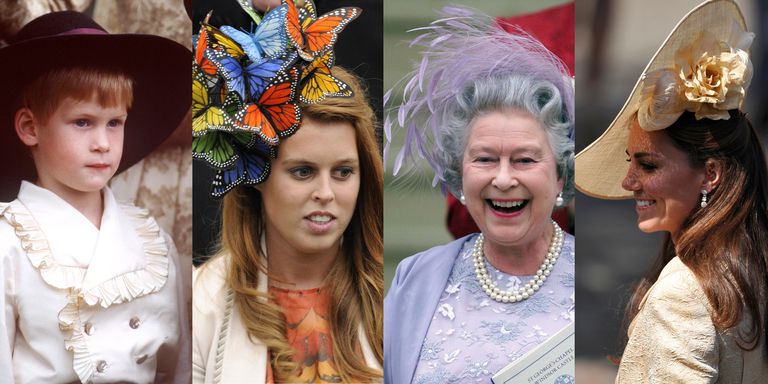At the wedding of Prince William and Kate Middleton, two things stuck out. Literally.
威廉王子和凯特·米德尔顿的婚礼上有两个引人注目的地方。我一点儿没有夸张。
The fascinators of princesses Beatrice and Eugenie.
那就是比阿特丽斯公主和尤金妮公主的装饰帽。
Sure, they were gigantic and pretty outlandish, but to be fair, the princesses were just following the dress code.
没错,她们的帽子确实有些大也有些古怪,但说句公道话,两位公主的帽子是符合王室着装要求的。
And on the wedding invitations to Prince Harry and Meghan Markle's wedding, you'll notice the same thing.
在哈里王子和梅根`马克尔的婚礼请柬上,大家也能注意到同样的着装要求。
You got to wear a hat.
嘉宾必须戴帽子。
Since the sixties, formal hats have sort of faded out of fashion.
六十年代以来,礼帽似乎已经有点儿过时了。
So how come British royals always seem to be wearing them?
那英国王室为什么还总是戴礼帽呢?
Hats have always served multiple functions.
帽子一直都有着多种作用。
They protect us from the cold and the Sun, they're symbols of religion or trade or military station.
能够抵御寒冷和骄阳,也被当做是宗教、贸易或军事基地的象征。
Or in the case of the top hat, they can show how stylish you are.
高顶礼帽则可以展示你是多么的时尚。
There's a really popular story that the first time a guy wore a top hat in London,
一个广为流传的故事就讲述了第一次有人在伦敦戴高顶礼帽的时候,
it caused such a stir that a woman fainted, dogs yelped, and a kid broke his arm in a mob.
如何引起了一个女人晕倒,群狗齐吠以及一个小孩在混乱中摔伤手臂的故事。
This probably didn't happen.
这个故事可能是杜撰的。
But it is true that top hats weren't really a thing in the UK until the early 19th century.
但高顶礼帽确实是在19世纪初以后才真正开始出现在英国的。
Beau Brummell, a fashion-forward dandy, introduced them to his friend and future king, George IV, and top hats officially received royal approval.
高顶礼帽在经由时尚先锋保罗·布鲁梅尔介绍给了他的朋友,未来的国王乔治四世后,正式获得了英国王室的认可。
Brummell was a big hat guy and he's also responsible for the decadent fashions you see at places like this.
布鲁梅尔是一个特别热衷高顶礼帽的家伙,大家在这种地方看到的如今已经衰微的时尚也是他带动起来的。
That's the Royal Ascot, the biggest race of the London social season.
这是英国皇家赛马会,伦敦社交季最盛大的赛事。
In 1807, it introduced the Gold Cup, a shorter race that brought larger crowds.
1807年还推出了金杯赛,尽管比赛时间变得更短了,围观的群众却更多了。
It was around this time that Brummell introduced a strict dress code for the race, so that even those from lower social classes looked the part.
就在这时,布鲁梅尔为比赛制定了严格的着装要求,如此一来,即使是底层社会的观众看起来也会比较体面。
Including Eliza Doolittle.
这其中就包括伊丽莎·杜利特尔。
Come on. Come on Dover. Come on Dover! Move your bloomin' arse!
加油。多佛加油。多佛加油!小屁屁动起来!
I suppose historically people have worn hats to the, to the races again, because of that formality.
我想从历史的角度来看,人们会重新戴上帽子来观看比赛是因为有这个着装要求。
Nowadays, you know, women like to dress up.
如今,你知道的,女人都喜欢打扮。
So if they're going to the races it's a fantastic excuse to to wear a hat.
去看比赛就是戴帽子的一个很好的借口。
That's Rachel Trevor Morgan who's made more than 80 hats for Queen Elizabeth II, including those she's worn to Royal Ascot.
这位是蕾切尔·特雷弗·摩根,她为伊丽莎白二世女王制作过80多顶帽子,包括她去看皇家赛马会时戴的那顶。
Brummell's dress code, now known as "Morning Dress," was the direct inspiration for races like this one.
布鲁梅尔的着装要求,现在被称之为“晨服”,为很多比赛提供了直接的灵感,比如这个比赛。
And it also became the de facto style of dress for all high society events held in the daytime.
它也确实成了上流社会白天举行的所有活动的服装风格。
Meanwhile women's hats ebbed and flowed according to fashion trends at court.
与此同时,女帽的款式也在随着王室时尚风格的变化而变化。
Bonnets in the early Victorian period, followed by tall ornamental hats, and then elaborate Edwardian creations with enormous brims.
维多利亚时代早期流行软帽,之后流行的是高大的装饰帽,接下来是那种精心制作的颇有爱德华七世时期风格的大沿帽。
At the end of the 19th century, we had women wearing hats all the time.
19世纪末英国的女性一直都会戴帽子。
They'd always go out wearing a hat.
出门的时候他们总是会戴着帽子。

After World War II, the traditional social season began to decline, as aristocrats abandoned their London homes.
二战结束后,随着贵族们逐渐遗弃伦敦的家,传统的社交季也开始衰落。
But morning dress still remained ,most notably at horse races and weddings.
但着晨服的习惯依然存在,尤其是在赛马和婚礼上。
I think there was a definite shift in hat wearing in the 1960s and I suppose it's because fashions became a bit more casual.
在我看来,20世纪60年代戴帽子的习惯发生了明显的变化,因为时尚变得更加随意了。
I think the young were experimenting with more exciting hairdos you know,
年轻人已经开始尝试各种精彩的发型,
you had beehive haircuts and people piling their hair up and then really short sharp cuts
有蜂窝头,盘发,还有很短的短发发型
and somehow it was left to the older generation to carry on that hat wearing, I think.
不知不觉地,就剩下老一辈的人保留了戴帽子的习惯了。
Hats were still, of course, required at the fanciest events for the fanciest people.
当然,戴帽子仍然是最精致的阶层出席最精致的活动时的一个着装要求。
Which is why hats tend to peak in popularity around the same time as royals do.
这就是为什么王室戴帽子的时候人群中戴帽子的人会最多的原因。
When Kate and William got married there was definitely an upsurge in hat wearing.
凯特和威廉结婚时人群中戴帽子的人的数量肯定急剧上涨了。
People looked at everybody attending the service and all the wonderful creations they had and they wanted a part of that.
人们看着参加婚礼的嘉宾们,看着制作精美的一切,他们也想参与到其中。
And when you think in the 1980s and we had Princess Diana, who always looked so beautiful and always wore hats.
当大家想到20世纪80年代,我们的戴安娜王妃总是会带着帽子,也总是显得那么漂亮。
And think of the Queen. She's a great hat wearer, so I, you know, I think it really does affect people.
再想想我们的女王,她也特别热衷于帽子,所以我认为,王室的这种时尚真的会影响到人。
And that's maybe the real reason why we associate British Royals with hats.
这也许也是我们总是将英国王室和帽子联系在一起的真正原因。
Whenever we see them, it's likely because there's a big event going on and for Royals, big events mean hats.
无论我们看到王室戴帽子是什么情形,都可能是一件很隆重的事情,对于王室来说,隆重就意味着要戴帽子。
People might want to wear a hat to stand out and because they're quite an extrovert,
外向的人戴帽子可能想靠戴帽子脱颖而出,
or they might want to wear a hat in order to sort of slightly hide behind.
也有人戴帽子是为了让自己躲在帽子后面。
And there are those people who've never worn hats and feel very awkward about the whole thing,
也有人从头到尾都觉得帽子很尴尬所以从来不戴,
but it's really satisfying when people come back saying, "that was fantastic, I really enjoyed it and had a great, positive experience."
但当人们回来说,“您设计的帽子简直太棒了,我喜欢得不得了,给我带来了一段非常好的体验。”,我会觉得很满足
So you can read quite a lot into people and it's getting to know where their comfort zone is.
从帽子中我们可以看出很多东西,我们可以看出一个人的舒适区的范围,
But they're a great sort of extension of people's characters I think.


